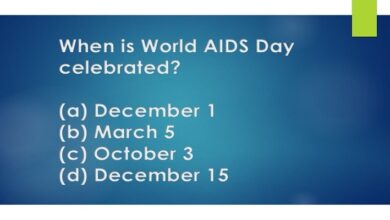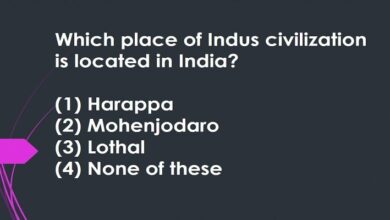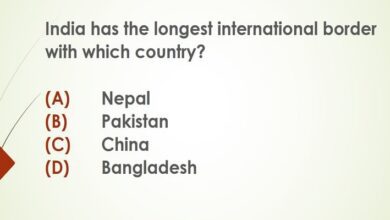50 GK Questions and Answers on Chemistry in English | PDF
GK Questions and Answers on Chemistry
GK Questions and Answers on Chemistry in English (Download PDF) – Chemistry is a subject that is beyond everyone’s understanding, but it is also true that questions are asked about this subject in government exams. Some important questions are often seen in examinations. Some of the important 50 questions and their answers are given below which is important from the exam point of view.
GK Questions and Answers on Chemistry
1. Who discovered the wave nature of electrons?
Ans. De Broglie
2. What is the smallest part of an element called?
Ans. Nuclear
3. According to Dalton’s atomic theory which is the smallest particle that can live freely?
Ans. Nuclear
4. The chemical behaviour of an atom depends on its –
Ans. On the number of electrons revolving around the nucleus
5. What is the mass number?
Ans. Proton and Neutron
6. The difference between the mass and the mass number of an atom is called –
Ans. Mass loss
7. Which nuclear particle has no mass and charge, but spins?
Ans. Neutron
8. The total energy of an electron revolving in an atom –
Ans. Always positive
9. By the scattering of which rays the size of the nucleus can be estimated?
Ans. A particle
10. The nucleus was discovered to be positive –
Ans. Rutherford
11. Who first proposed the atomic theory of matter?
Ans. John Dalton
12. Which of the following is a floating particle?
Ans. Neutron
13. Which one correctly determines the atomic number of an element?
Ans. Number of protons
14. What are the particles in the nucleus of an atom?
Ans. Electron and Neutron
15. Which of the following is a chargeless particle?
Ans. Neutron
16. What are the basic particles in an atom in equal numbers?
Ans. Electron and Proton
17. Who was the first to determine the charge of an electron?
Ans. Millikan
18. Rutherford’s scattering proved the existence of
Ans. The nucleus of an atom
19. Atomic Electricity is –
Ans. Indifferent look
20. The electron was discovered by?
Ans. Thomson
21. Who discovered the proton?
Ans. Rutherford
22. What was discovered by James Chadwick?
Ans. Neutron
23. In which of the following particles, the dipole nature of the beam wave is found?
Ans. Neutron
24. Who is the discoverer of positron?
Ans. Anderson
25. Who discovered the atomic nucleus?
Ans. Rutherford
26. An Indian scientist whose name is associated with a particle of a specific origin-
Ans. Boss
27. What is the name of the scientist who detected the neutron?
Ans. Chadwick
28. Which atom does not have a single neutron in its nucleus?
Ans. Hydrogen
29. What is the International Standard for Atomic Weight?
Ans. C-12
30. Positron is the replica of what?
Ans. Electron
31. Who among the following propounded the atomic theory?
Ans. Dalton
32. With respect to the molecule of a chemical element, the magnetic quantum number is related to-
Ans. By rotation
33. An atom has 9 electrons and 10 neutrons, what will be its mass number?
Ans. 19
34. What will be the mass number of the element whose atom has 2 protons, 2 neutrons and 2 electrons?
Ans. 4
35. If the third orbital of an atom is the outermost orbit, then what is the maximum number of electrons it can have?
Ans. 18
36. The atomic number of an atom is Z and its mass number is M, then what will be the number of neutrons in its nucleus?
Ans. M-Z
37. The nucleus of a chlorine atom of atomic number 17 and mass number 35 consists of
Ans. 18 neutrons
38. The electronic configuration of an atom with atomic number 20 is-
Ans. 2,8,8,2
39. Which of the following electronic configuration is for a metallic element?
Ans. 2,8,8,2
40. Which of the following electronic structure belongs to sodium ion?
Ans. 2,8
41. Rutherford discovered the nucleus by studying the scattering of which from gold paper?
Ans. A particle
42. When an electron moves from a higher orbit to a lower orbit,
Ans. Energy is released
43. What is the number of core electrons in sodium atom?
Ans. 10
44. The electronic configuration of an atom is 2,8,2, then what is the number of valence electrons in it?
Ans. 2
45. Electronics do not pair until the empty cell received for them is exhausted, this rule is called-
Ans. Hundas rule
46. Who propounded the uncertainty principle?
Ans. Heisenberg
47. What is the maximum number of atoms that an element can have in its second orbit?
Ans. 8
48. The atomic number of carbon is 6 and atomic weight is 12, then how many electrons are there in its nucleus?
Ans. 6
49. The electronic number in an atom of atomic number Z and mass number A is?
Ans. Z
50. The atomic number of an element is 35 and it has 14 electrons, then what will be the number of protons in it?
Ans. 18
Download PDF – Click Here
Read also –




